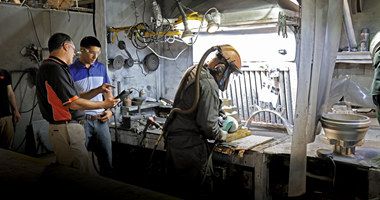
Optimizing Workplace Efficiency and Savings with Pneumatic Tools
In the dynamic landscape of modern business operations, the quest for tools that seamlessly integrate efficiency, safety, and cost-effectiveness has become paramount. Pneumatic tools have emerged as a strategic solution, garnering attention across diverse industries.
In the dynamic landscape of modern business operations, the quest for tools that seamlessly integrate efficiency, safety, and cost-effectiveness has become paramount. Pneumatic tools have emerged as a strategic solution, garnering attention across diverse industries. This comprehensive guide delves into the merits and practical insights for seamlessly integrating pneumatic tools into your corporate toolkit.
Recognizing the Operational Imperative
In the pursuit of operational excellence, businesses are increasingly turning to tools that not only enhance efficiency but also prioritize safety and financial prudence. Pneumatic tools have positioned themselves as an operational imperative, offering a trifecta of benefits that resonate across various industries.
The inherent nature of pneumatic tools, powered by compressed air, renders them a safer alternative to traditional electrical tools. The absence of electrical components reduces the risk of electrical malfunctions, shocks, and fires, contributing significantly to workplace safety. Moreover, the efficiency and precision of pneumatic tools in various applications make them an attractive proposition for businesses aiming to optimize their operational processes.
Transitioning to Pneumatic Tools
Purchasing pneumatic tools, exemplified by the renowned Dynabrade Straight-Line Extension Die Grinder (model 53781), presents a compelling economic advantage. One of the standout benefits is a substantial reduction in purchasing costs. In a direct comparison with traditional electrical tools, the Dynabrade 53781 offers a remarkable cost reduction.
This significant cost disparity makes a compelling case for businesses looking to optimize their budgets without compromising on the quality and efficiency of their tools. The initial investment in pneumatic tools proves to be a strategic move towards long-term financial prudence.
Prioritizing Workplace Safety
Ensuring workplace safety is a non-negotiable aspect of any business operation. Pneumatic tools contribute to a safer working environment through a combination of design features and operational characteristics.
- Comprehensive Training: Thorough training programs for operators and craftsmen are pivotal in ensuring the safe and efficient use of pneumatic tools. This training encompasses understanding the unique features, operational nuances, and safety protocols associated with pneumatic tools.
- Routine Maintenance Protocols: Instituting regular maintenance routines for pneumatic tools is a kin to a proactive healthcare regimen for your operational toolkit. Regular checks and preventive maintenance not only extend the lifespan of the tools but also ensure consistent and optimal performance.
Streamlining Operational Costs through Maintenance
Beyond the initial purchase, businesses stand to gain significant cost savings through reduced maintenance requirements with pneumatic tools. Reduced Repair Frequency: The disparity in repair frequencies between traditional electric machines and pneumatic tools is a key consideration. Traditional electric machines often require monthly repairs, resulting in a substantial expense each time.
By contrast, Dynabrade Power tools require less attention, with a significantly lower maintenance cost per cycle. This difference highlights the economic benefits of pneumatic tools, presenting a tangible reduction in ongoing operational costs.
Conclusion: Optimizing with Pneumatic Precision
In summary, the strategic adoption of pneumatic tools, particularly exemplified by the Dynabrade 53781, holds the key to a safer, streamlined, and cost-efficient business environment. As businesses navigate the evolving landscape, the integration of pneumatic tools into their operational framework becomes a judicious investment. The economic advantages, coupled with the inherent safety features and reduced maintenance costs, position pneumatic tools as a catalyst for operational optimization.
Whether in manufacturing, construction, or other industries, businesses can leverage the precision and efficiency of pneumatic tools to propel their operations into a future marked by safety, cost-effectiveness, and operational excellence. As you assess purchasing and maintenance costs, it becomes evident that pneumatic tools stand as more than mere tools; they are strategic assets that contribute to the overall resilience and efficiency of your business. Navigate your business towards operational excellence and fiscal prudence by embracing the precision of pneumatic tools in your corporate toolkit.